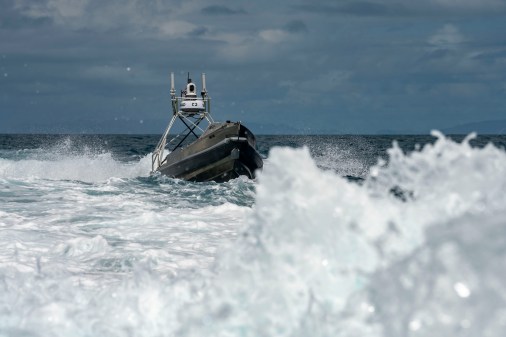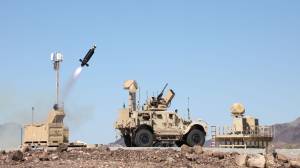Originally published CNO Franchetti: ‘We’re continuing to learn’ countering drones, missiles in the Red Sea on by https://defensescoop.com/2024/10/02/cno-franchetti-were-continuing-to-learn-countering-drones-missiles-in-the-red-sea/ at DefenseScoop
Close
The Navy’s top officer described lessons learned from ships countering drones and missiles fired by Houthis in the Red Sea.

One of the key lessons from the Navy’s recent engagements with Houthi missiles and drones in the Red Sea is being adaptable on the battlefield to use existing systems differently.
Over the last year, Navy assets in the region have come under fire from a barrage of systems launched by the Houthis — a group backed by Iran that has controlled portions of Yemen, including the capital, since 2014 — to include one-way drones and missiles. Navy ships have used a variety of expensive missiles to shoot down these assets, leading many outside experts to ask if the sea service and the Department of Defense are on the wrong side of the cost curve, shooting down inexpensive projectiles with million-dollar ammunition.
“The other lesson learned … is really using what you have differently. Using Hellfire against unmanned surface vehicles, air-to-air, aviation platform shooting down UAVs,” Adm. Lisa Franchetti, chief of naval operations, told reporters during a roundtable Wednesday hosted by the Defense Writers Group. “These are things where we’re really learning. I think that Ukraine has shown us that you can innovate on the battlefield. I want to innovate before the battlefield, so we can stay ahead of any adversary any time.”
Navy aircraft had previously been used to shoot down several missiles and drones fired by the Houthis.
Franchetti noted that there isn’t a price tag for the lives of the sailors being targeted by the Houthis, a refrain echoed by top officials alluding to the fact they will use whatever capabilities at their disposal — regardless of how expensive — to protect personnel.
“I’m very proud of them, speaking with them directly. They have been in a weapons engagement zone and working at a level of intensity really never seen in my lifetime and really since World War II. I am very grateful for the weapons systems we have and for their ability to deploy them,” she said. “We’ve learned [that] conventional platforms [are] defeating unmanned platforms. We see that again every day that our ships are there and that our weapon systems and our training process that we’ve invested in over the last 10 to 15 years has really paid off. Our weapons are working as designed, our people know how to use them as designed and I think that confidence is really important as they integrate our capabilities along with the capabilities of the Air Force with allies and partners there.”
Though she declined to offer specific lessons and applications for assets currently deployed to avoid touching on ongoing operations, Franchetti acknowledged that the joint services along with allies and partners will all continue to contribute capabilities to thwart these types of threats in the future.
“You learn a couple things from that [engagement]. One is the power of allies and partners being able to work together. Like-minded nations to stand up again for that rules-based international order … it just reiterates the value of allies and partners, which our adversaries simply don’t have,” she said. “It’s clear that unmanned platforms are part of that changing character of war … you also need to be able to defeat them. This is a strong area of focus for our secretary of defense. He’s really put a lot of emphasis on counter-UAS and using creative solutions to get after that. We’re focused on that too. I think there’s some – all five services, are working on that, so there’ll be some integrated capabilities that we’re able to come up with.”
One of the biggest lessons Franchetti touted was the ability to take data from weapon systems to learn and improve tactics. Engineers can work with industry to devise fixes against these capabilities the Houthis are employing — which includes the best Iranian technology the Islamic Republic is supplying — in an ongoing cat-and-mouse game.
“We’re continuing to learn,” Franchetti said. “We know that this change in the character of war is that we are going to have to be able to defeat those types of technologies, whether it’s kinetically or non-kinetically or … farther left of launch and look forward to working on that.”
More Scoops

Navy CNO unveils ‘Project 33’ with a heavy emphasis on robotic systems, information dominance
The forthcoming push is part of Adm. Lisa Franchetti’s “CNO Navigation Plan.”
By
Jon Harper

Pentagon to test whether counter-drone systems can operate effectively under electronic attack
By
Jon Harper

Senators amplify concerns about pace of fielding AI-enabled counter-drone systems
By
Jon Harper
Latest Podcasts
Originally published DefenseScoop

